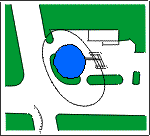EPA On-line Tools for Site Assessment Calculation
| Module Home Objectives Table of Contents Previous < Next > |
| 36 of 45 |
Source Benzene Concentration
The effective solubility calculator can be used to estimate expected water phase concentrations of chemicals that compose fuels. Note the careful wording: since the fuels are composed of many chemicals, the solubility of any given chemical will not equal is aqueous solubility. For example, the solubility of benzene is often given as 1780 mg/L. This is the solubility of liquid benzene, not the effective solubility of benzene that results from contact between a mixture of chemicals that includes benzene (the fuel) and water.
At this site, like most sites, the release occurred before the site investigation commenced. It's impossible to go back in time to collect a sample of the fuel and analyse it so that we would know its composition. The composition is one required input for effective solubility calculation. To estimate the effective solubility without a site-specific fuel composition means were looking for a ball-park answer. We'll use some example fuels to estiamate effective solubility.
|
Home | Glossary | Notation | Links | References | Calculators |


